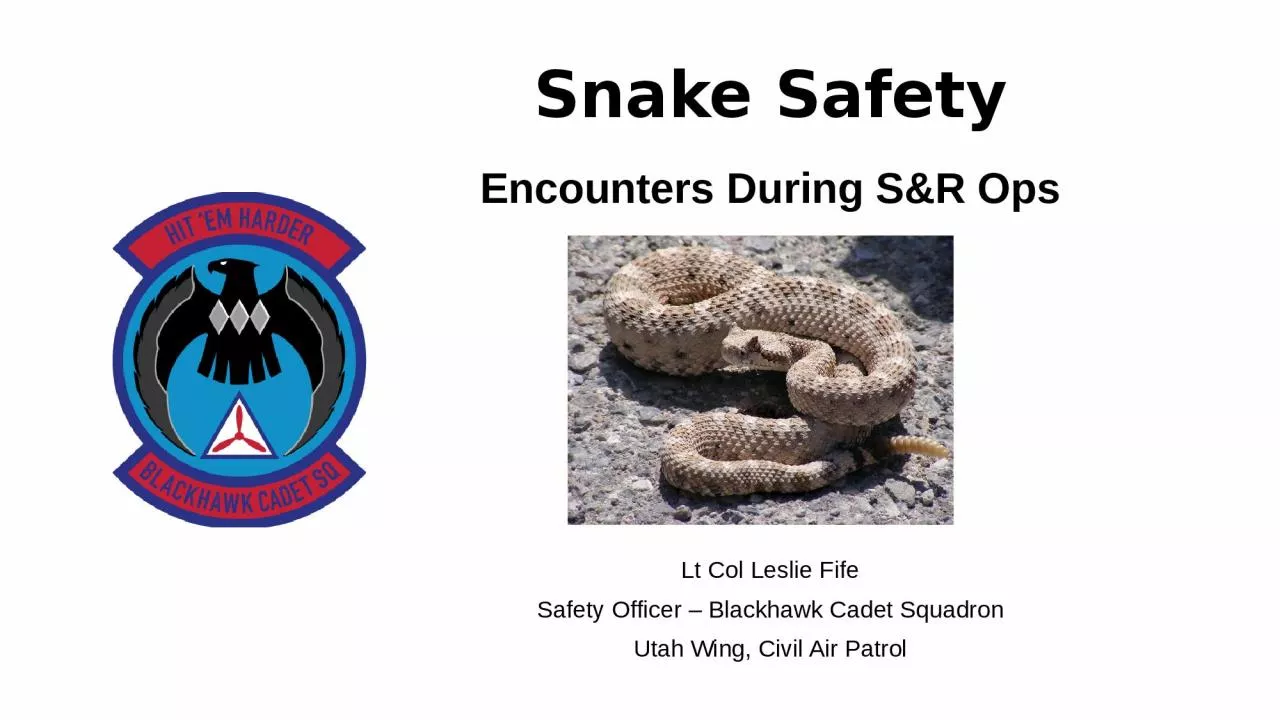

Lt Col Leslie Fife Safety Officer Blackhawk Cadet Squadron Utah Wing Civil Air Patrol Ground Teams often do Search amp Rescue in remote areas wooded terrain and other low traffic areas These are the kind of environments that are shared with various animals some of which are dangerous ID: 1018418
Download Presentation The PPT/PDF document "Snake Safety Encounters During S&R O..." is the property of its rightful owner. Permission is granted to download and print the materials on this web site for personal, non-commercial use only, and to display it on your personal computer provided you do not modify the materials and that you retain all copyright notices contained in the materials. By downloading content from our website, you accept the terms of this agreement.
1. Snake SafetyEncounters During S&R OpsLt Col Leslie FifeSafety Officer – Blackhawk Cadet SquadronUtah Wing, Civil Air Patrol
2. Ground Teams often do Search & Rescue in remote areas, wooded terrain, and other low traffic areas.These are the kind of environments that are shared with various animals, some of which are dangerous.This briefing will concentrate on SNAKESWith proper care, you can remain safe.Snake SafetyOverview
3. Snakes are “elongated, legless, carnivorous reptiles” (Wikipedia.com)Snakes come in a variety of sizes and colors. They can be either venomous or non-venomous.Our goal is NOT to get up close and personal to determine which are venomous or dangerous. Avoid all snakes.Snake SafetySubject
4. About 8000 people are bitten by venomous snakes each year with 10-15 deaths.Most bites occur between April and October. Most snakes will attempt to avoid you, but do not rely on that.Snake SafetyJust the Facts
5. Do not put your hands or feet anywhere you cannot see. Be especially careful around logs and rocks.Wear boots, preferably leather.Wear gloves, preferably leather.Snake SafetyRisk Controls
6. Be cautious when off the trail, traveling through tall grass or through the brush.At night, use a flashlight.Be careful in the water – some snakes can swim. The “stick” might be a snake.Snake SafetyRisk Controls
7. If the snake looks dead – DO NOT pick it up.If you hear a rattling sound – AVOID the area. (Not all snakes Rattle)If you see a snake, AVOID it.Snake SafetyRisk Controls
8. DO NOT apply a tourniquet.DO NOT apply ice or cold compresses or hot packs.DO NOT cut into the bite with a knife.DO NOT try to suck out the venom.DO NOT try to capture the snake. DO NOT take aspirin or alcohol.Snake SafetyFirst Aid – DON’Ts
9. DO Seek immediate medical attention.DO Keep calm. Carry them if possible.DO Loosen restrictive clothing and jewelry. The area may swell.DO Keep the bite area below the heart.Snake SafetyFirst Aid - DOs
10. Use your situational awareness to recognize places snakes may be, and be careful where you put your hands and feet.Snakes are beneficial are just want to be left alone. LEAVE THEM ALONE – even if they appear dead.The danger from snakes is manageable.Summary
11. https://www.fs.usda.gov/Internet/FSE_DOCUMENTS/stelprdb5393596.pdfhttps://americanhiking.org/wp-content/uploads/2013/04/Snake-Bites-fact-sheet.pdfhttps://tpwd.texas.gov/education/resources/texas-junior-naturalists/be-nature-safe/venomous-snake-safetyhttps://srelherp.uga.edu/snakes/snake-safety.htmhttps://health.ucdavis.edu/welcome/features/2015-2016/09/20150918_rattlesnake-bites.htmlhttps://en.wikipedia.org/wiki/SnakeReferences